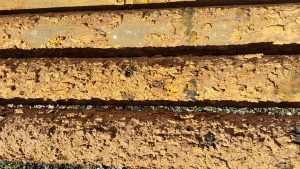What are some common issues found in aged wells that can be detected with a camera inspection
Deposition in water wells that can be recognized with video inspection consists of three categories including physical, chemical, and biological clogging. It is worth noting that the way that clogging may occur in the water well is less important than reducing water yield and energy.
1. Physical clogging (sedimentation on screen):
Debris, sludge, and other substances can block water from entering wells causing a decrease in water discharge. This blockage occurs when materials accumulate and clog the screen’s perforations. The debris can enter wells through holes created by corrosion over-pumping or incomplete well development However, removing this debris from the perforations is a relatively simple process. The most effective method is the Nitro-Pulse® technology which uses compressed air. But before rehabilitating the water well it is necessary to inspect it using videometry techniques to identify the rate and location of deposition. This ensures that the removal of depositions on the screen is effective.
2. Biological clogging (biofilm)
The bacteria that commonly exist in soil also exist in groundwater which is why screens get clogged. This bacteria has three main categories: iron-reducing bacteria (IRB) sulfate-reducing bacteria (SRB) and bacteria-causing sludge. Among these categories, farmers are most familiar with the bacteria responsible for reducing iron and producing sludge.

- Iron-reducing bacteria (IRB):
Groundwater usually contains various concentrations of iron ions in its composition which depends on depth. Detecting iron in irrigation water is easy because this changes the color of water making plaque on the skin of pumps, pipes, and irrigation equipment. Typically while pumping the odor of rotten eggs or the gas of hydrogen sulfide (H2S) is usually noticeable. Generally, if the concentration of iron ions is more than 0.3 ppm (part per million) the issues caused by this kind of bacteria will be created. Despite this low concentrations of iron ions could cause a suitable environment to grow these bacteria. These bacteria create a narrow organic matter on the screen, casing, and pump, and accumulation of this matter within wells causes a reduction of annulus space of water boreholes resulting in the reduction of water yield. In addition, adding more oxygen to this environment leads to hardening the sedimentation which removing it more difficult.
- Sulfate-reducing bacteria (SRB):
It is common to find a high concentration of sulfate in groundwater. When sulfate-reducing bacteria consume sulfate it produces organic acid and hydrogen sulfate which has an unpleasant odor of rotten eggs. These bacteria can survive without oxygen as they are anaerobic. They live in environments where oxygen concentration is low so getting rid of them is not an easy task.
- bacteria-causing sludge
Bacteria that produce sludge and biofilms coexist with sulfate-reducing and iron-reducing bacteria. This results in the formation of sludge which is commonly seen when a pump is removed from a water borehole.
3. Chemical logging:
This refers to a type of blockage that is caused by mineral deposits on the surface of the screen and casing leading to the formation of chemical sedimentary rocks. This can also result in the cementation of sand and debris within the borehole resulting in forming sandstones and conglomerates. To deal with this problem a video inspection is necessary to identify the issue, sediment deposits, and the rate of sedimentation.
4. Fracture and deformation of casing:
Due to land subsidence deformation or fracturing of casing may be occurred. Typically these issues may lead to sand production. Sand production usually causes sticking a pump and its accessories in the borehole as well as reduces water yield. After removing a pump from the borehole to repair the casing and inspect the circumstances of the borehole’s condition a camera inspection will be done.

